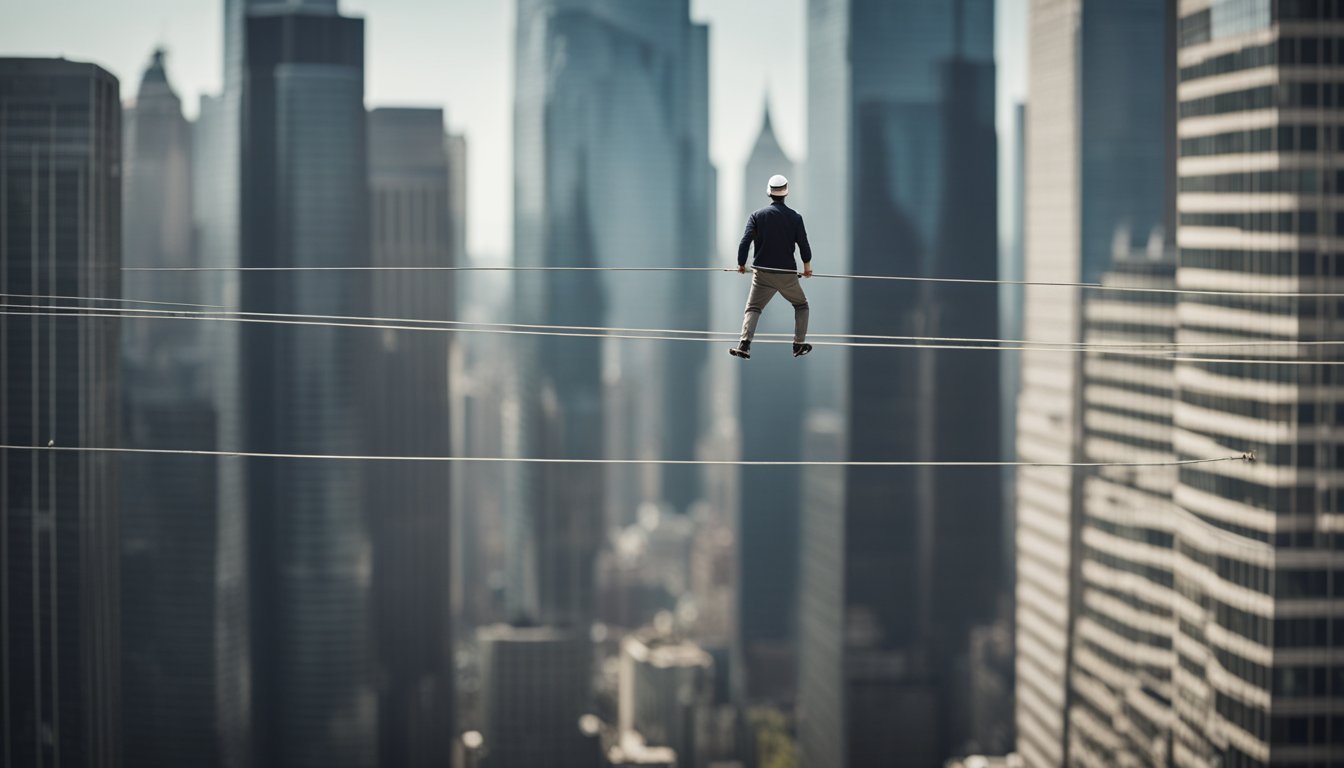Man on Wire Reenactment Controversy Examines Documentary Authenticity
James Marsh's documentary "Man on Wire" captivated audiences with its thrilling portrayal of Philippe Petit's daring high-wire walk between the Twin Towers in 1974. The film's use of reenactments to bring this historic feat to life sparked discussions about the blurring of fact and fiction in documentary filmmaking.
The copious and stylish reenactments in "Man on Wire" push the boundaries of traditional documentary techniques, raising questions about authenticity and artistic license. While these reconstructed scenes add visual flair and help viewers imagine the audacious wire-walk, critics argue they potentially undermine the film's commitment to factual representation.
The controversy surrounding "Man on Wire" highlights a broader trend in modern documentaries, where filmmakers increasingly employ dramatic recreations to enhance storytelling. This approach challenges viewers to discern between authentic footage and staged scenes, blurring the once-clear line between documentary and narrative filmmaking.
Reenactment in Documentary Film
Reenactments play a complex role in documentary filmmaking, blurring the line between fact and fiction. They offer unique storytelling opportunities but raise questions about authenticity and ethics.
Historical Context and Evolution
Reenactments in documentaries date back to the early days of cinema. In the 1920s, Robert Flaherty used staged scenes in "Nanook of the North" to capture Inuit life. This practice evolved over time, gaining prominence in the 1980s with films like Errol Morris's "The Thin Blue Line."
As technology advanced, reenactments became more sophisticated. Filmmakers began using actors, props, and special effects to recreate events. This trend continued into the 21st century, with documentaries like "The Act of Killing" pushing boundaries by having perpetrators reenact their crimes.
The Role of Reenactments
Reenactments serve multiple purposes in documentaries. They can:
Visualize events with no existing footage
Add emotional impact to stories
Clarify complex sequences of events
Engage audiences through dramatic storytelling
When used effectively, reenactments can enhance the viewer's understanding of historical events or personal experiences. They bridge gaps in visual evidence and bring abstract concepts to life.
Ethical Considerations
The use of reenactments in documentaries raises ethical questions. Critics argue they can:
Mislead viewers about what is real footage
Manipulate emotions and perceptions
Compromise the documentary's claim to truth
Filmmakers must balance storytelling with a commitment to accuracy. Clear labeling of reenacted scenes and transparency about methods can help maintain trust with audiences.
Some documentarians avoid reenactments entirely, believing they undermine nonfiction storytelling. Others see them as valuable tools when used responsibly and in service of deeper truths.
'Man on Wire': Blurring Realities
James Marsh's documentary "Man on Wire" masterfully blends fact and fiction to recount Philippe Petit's daring 1974 high-wire walk between the Twin Towers. The film employs innovative techniques to recreate this historic event, challenging traditional documentary conventions.
Analyzing 'Man on Wire'
Marsh's approach in "Man on Wire" combines archival footage with dramatic reenactments. Real interviews and photographs are interspersed with stylized recreations of key moments. This blend of reality and performance creates a vivid, immersive experience for viewers.
The film's reenactments are carefully crafted to match the tone and style of the original footage. Actors portraying Petit and his team mimic their real-life counterparts' mannerisms and appearance. These scenes are shot in black and white, seamlessly integrating with authentic archival material.
Marsh's use of reenactments serves to fill gaps in the historical record. It allows the audience to visualize moments that were not captured on camera, enhancing the narrative's emotional impact.
Audience Perception and Reaction
The blurring of fact and fiction in "Man on Wire" elicits complex reactions from viewers. Many find the film's approach captivating, praising its ability to transport them into Petit's world. The reenactments add tension and drama, making the story more engaging.
Some critics, however, question the ethics of mixing documentary and fictional elements. They argue that this approach may mislead audiences about what truly occurred. The film's seamless integration of real and recreated footage can make it difficult to distinguish between the two.
Despite these concerns, "Man on Wire" has been widely acclaimed for its innovative storytelling. It won numerous awards, including the Academy Award for Best Documentary Feature in 2009.
Representational Strategies
Marsh employs various strategies to represent Petit's high-wire walk. The film uses a mix of archival photographs, interviews with participants, and dramatic reconstructions. This multi-layered approach creates a rich, textured narrative.
The reenactments are carefully staged to evoke the emotions and tension of the original event. Actors' performances are restrained, avoiding melodrama. The film's pacing builds suspense, mirroring the meticulous planning that went into Petit's feat.
Visual effects are used sparingly, enhancing rather than overshadowing the real-life elements. The film's sound design also plays a crucial role, combining authentic audio recordings with carefully crafted soundscapes to immerse viewers in the experience.
The Filmmaker's Perspective
Documentary directors often grapple with how to portray reality on screen. Their creative choices shape audience perceptions of truth and authenticity in nonfiction filmmaking.
Errol Morris on Reenactment
Errol Morris pioneered the use of dramatic reenactments in documentaries. He argues reenactments can reveal deeper truths than raw footage alone. In "The Thin Blue Line," Morris used stylized recreations to cast doubt on a murder conviction.
His approach sparked debate about truth in nonfiction film. Morris contends reenactments are a valid investigative tool. He uses them to visualize conflicting testimonies or hypothetical scenarios.
Critics argue reenactments blur fact and fiction. Morris counters that all filmmaking involves manipulation. He believes reenactments can illuminate reality rather than obscure it.
Werner Herzog's 'Ecstatic Truth'
Werner Herzog coined the term "ecstatic truth" to describe his documentary philosophy. He seeks to capture emotional or poetic truths beyond literal facts. Herzog often stages scenes or gives direction to subjects.
In "Little Dieter Needs to Fly," Herzog had the subject reenact his experiences as a prisoner of war. He argues this approach revealed Dieter's psychological state more vividly than interviews alone.
Herzog dismisses the idea of objective truth in documentaries. He views filmmaking as a creative act that should strive for deeper meaning. His methods challenge traditional notions of documentary ethics.
Robert Greene's Approach to Nonfiction
Robert Greene blends documentary and fictional techniques in his films. He openly acknowledges the artifice of filmmaking. Greene often has subjects play versions of themselves in staged scenarios.
His film "Kate Plays Christine" follows an actress preparing to portray a real person. It explores how performers construct truth through acting. Greene shows the process of creating a character based on limited facts.
He argues traditional documentaries can be manipulative despite claims of objectivity. Greene's hybrid approach aims for transparency about the filmmaking process. He invites viewers to question how nonfiction stories are constructed.
Reenactment and Storytelling
Reenactments blend storytelling techniques with historical events, creating a powerful fusion of fact and fiction. This approach allows filmmakers to engage audiences on both intellectual and emotional levels.
The Power of Narrative
Storytelling captivates viewers by tapping into universal human experiences. Reenactments in documentaries like "Man on Wire" leverage this power to bring historical events to life.
These dramatized scenes provide visual context, helping audiences connect with the subject matter. By recreating key moments, filmmakers can highlight emotional beats and build tension.
Reenactments also fill gaps where archival footage is unavailable. This technique allows directors to present a cohesive narrative arc, even when dealing with fragmented historical records.
Merging Fiction and Nonfiction
The line between fact and fiction blurs when documentaries incorporate reenactments. This fusion creates a unique viewing experience that combines the authenticity of real events with the narrative structure of fiction.
Filmmakers must balance historical accuracy with storytelling needs. They often take creative liberties to enhance dramatic effect or clarify complex situations.
Critics argue that reenactments can potentially mislead viewers. However, supporters contend that these scenes offer valuable insights into historical events when used responsibly.
Ethical considerations come into play when deciding how to present reenacted material. Clear labeling and contextual information help maintain transparency.
Simulations and Imagination
Reenactments serve as simulations of past events, inviting viewers to imagine themselves in historical situations. This immersive quality enhances audience engagement and empathy.
By visually reconstructing scenes, filmmakers activate viewers' imaginations. This process allows audiences to fill in sensory details and emotional nuances not explicitly shown on screen.
Reenactments can also challenge preconceptions about historical events. By presenting alternative perspectives or lesser-known details, they encourage viewers to reconsider established narratives.
The use of actors in reenactments adds another layer of interpretation. Their performances shape how audiences perceive historical figures and events.
Examining Authenticity
The line between fact and fiction blurs in 'Man on Wire' as the film explores the nature of truth and authenticity. The reenactments raise questions about how documentary filmmaking can represent reality while employing fictional techniques.
Seeking the Truth
'Man on Wire' uses reenactments to fill gaps where no archival footage exists. These staged scenes aim to recreate Philippe Petit's 1974 high-wire walk between the Twin Towers. The film mixes genuine historical material with carefully reconstructed moments.
This blending of real and recreated content challenges viewers to discern fact from fiction. The reenactments allow the filmmakers to visually depict key events, but their inclusion complicates the documentary's claim to truth.
Critics debate whether these dramatized segments enhance or undermine the film's authenticity. Some argue they provide necessary context, while others feel they compromise the documentary's integrity.
Audience's Quest for Authenticity
Viewers often approach documentaries expecting unvarnished truth. 'Man on Wire' tests this assumption by incorporating fictional elements into its nonfiction narrative.
The film's use of reenactments forces audiences to actively engage with the material. Viewers must determine which scenes depict actual events and which are reconstructions.
This blurring of boundaries can be seen as both a strength and weakness. It creates a more immersive experience but may leave some questioning the film's reliability as a historical document.
The controversy surrounding 'Man on Wire' highlights broader debates about authenticity in documentary filmmaking. It raises important questions about how truth can be represented on screen.
Cultural and Societal Impact
Reenactments in historical documentaries like "Man on Wire" raise important questions about representation and cultural memory. They shape public perceptions of past events and influence how history is understood and remembered.
Representation in Reenactments
Reenactments in documentaries often face scrutiny for their portrayal of historical figures and events. The casting choices and visual depictions can reinforce or challenge existing narratives. In "Man on Wire," the reenactments of Philippe Petit's wire-walk between the Twin Towers sparked debates about authenticity and artistic license.
Critics argue that reenactments may oversimplify complex historical moments. Supporters contend they make history more accessible and engaging. The representation of race, gender, and ethnicity in reenactments is particularly sensitive. Filmmakers must navigate these issues carefully to avoid perpetuating stereotypes or erasing marginalized voices.
American History and Civil War Reenactments
Civil War reenactments are a prominent example of historical reenactment in American culture. These events draw thousands of participants and spectators annually. Proponents argue they preserve history and educate the public about a pivotal period in American history.
However, Civil War reenactments face criticism for potentially romanticizing a conflict rooted in slavery. The representation of Black men in these reenactments is often limited or problematic. Some reenactors focus on military tactics and daily life, while others incorporate discussions of slavery and its role in the war.
Critics argue these events can perpetuate Lost Cause mythology. Supporters claim they foster understanding of soldiers' experiences. The ongoing debate reflects broader cultural discussions about how America remembers and interprets its complex history.
Controversies and Criticisms
James Marsh's documentary "Man on Wire" sparked debates about the use of reenactments in non-fiction filmmaking. Critics questioned the blending of fact and fiction, while others praised the film's innovative approach to storytelling.
Challenging the Boundaries
Marsh's extensive use of reenactments in "Man on Wire" pushed the boundaries of traditional documentary filmmaking. Some viewers felt misled by the seamless integration of staged scenes with archival footage.
The film's dramatic recreations of Philippe Petit's wire-walking preparations raised concerns about authenticity. Critics argued that these fictional elements compromised the documentary's credibility.
Supporters countered that the reenactments enhanced the audience's understanding of Petit's daring feat. They claimed the stylized scenes captured the emotional truth of the events, even if not strictly factual.
Public and Critical Reception
"Man on Wire" received widespread acclaim from audiences and critics alike. Many praised Marsh's innovative approach to documentary storytelling.
The film won numerous awards, including the Academy Award for Best Documentary Feature. This recognition validated its artistic merits in the eyes of many industry professionals.
Some documentary purists, however, criticized the blurring of fact and fiction. They argued that reenactments undermined the genre's commitment to truth and objectivity.
The controversy sparked broader discussions about the nature of truth in documentary filmmaking. It challenged audiences to reconsider their expectations of non-fiction cinema.
Conclusion
"Man on Wire" sparked debate over the use of reenactments in documentary filmmaking. The film's stylized recreations blurred lines between fact and fiction, challenging traditional notions of documentary authenticity.
Reenactments allowed director James Marsh to vividly portray Philippe Petit's daring high-wire walk. These scenes filled crucial gaps in the historical record and brought the story to life for viewers.
Critics argued the extensive use of reenactments undermined the film's credibility as a documentary. Supporters countered that the recreations enhanced audience engagement and understanding of Petit's feat.
The controversy highlighted evolving perspectives on documentary storytelling techniques. It raised questions about balancing factual accuracy with creative artistic expression.
"Man on Wire" exemplified a trend toward more cinematic approaches in nonfiction filmmaking. Its success demonstrated audiences' willingness to accept dramatized elements within documentary narratives.
The film's impact continues to influence discussions on documentary ethics and storytelling methods. It remains a touchstone for debates on authenticity and creative license in nonfiction cinema.







